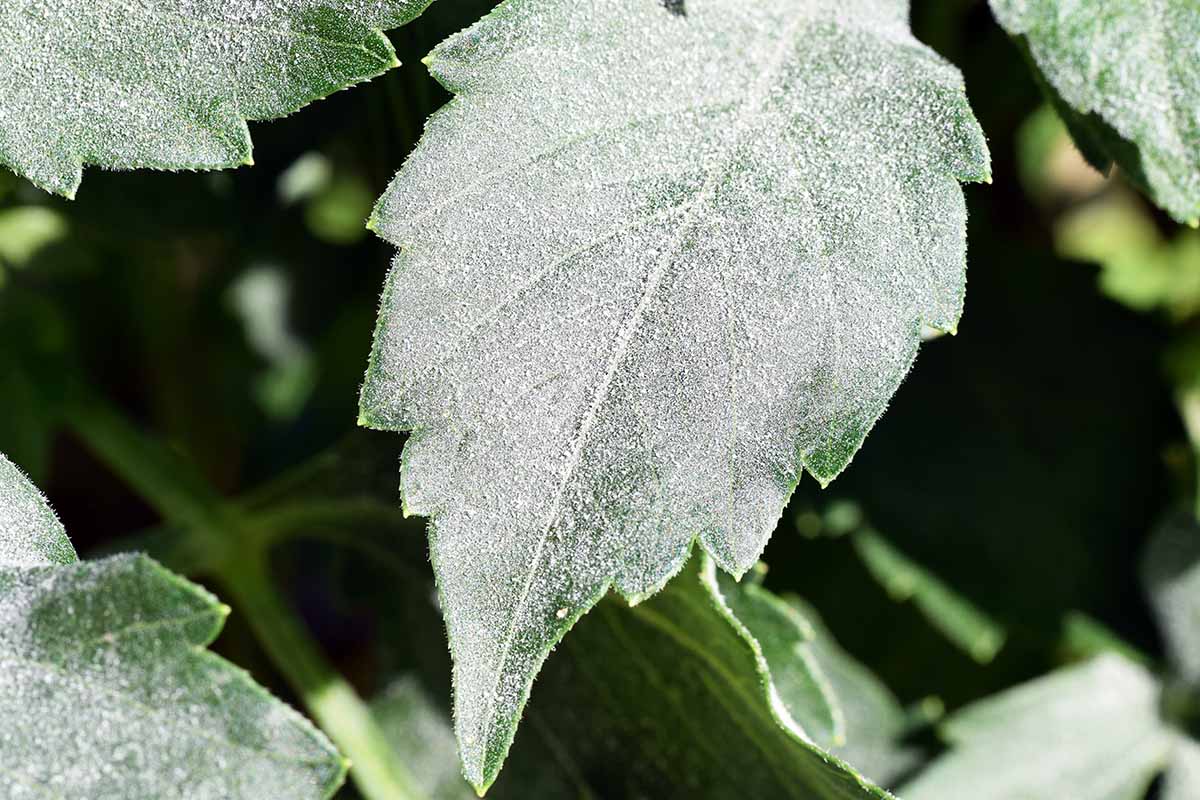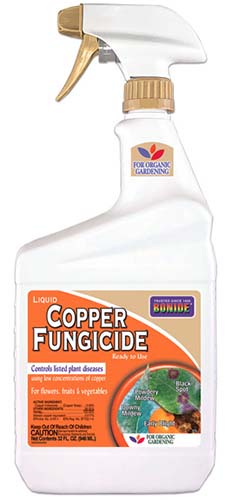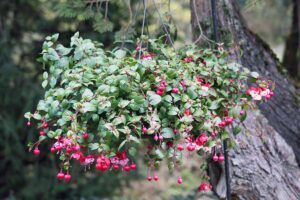When it comes to fungal diseases in dahlias, there are some really nasty ones to contend with.
Botrytis mold and root rot can kill your tubers quickly, and without much warning. Damping off can stop your seedlings in their tracks.
Powdery mildew, on the other hand, is more of an aesthetic problem.
It doesn’t usually kill the plant because the fungus can’t survive without living plant tissue. It’s to the pathogen’s advantage to keep its host alive.

We link to vendors to help you find relevant products. If you buy from one of our links, we may earn a commission.
Still, that doesn’t mean we want the distorted leaves, stunted growth, and ugly mildew to mar our plants.
If you need a quick refresher on how to grow and care for dahlias, pop on over to our guide.
In this guide, we’re going to discuss powdery mildew in dahlias and what to do about it.
Here’s what I’ll cover:
What You’ll Learn
What Causes Powdery Mildew?
As I mentioned, powdery mildew is a fungal disease. It’s caused by Erysiphe cichoracearum and E. polygoni.
These pathogens are obligate parasites, which means they can’t complete their lifecycle if they don’t have a living host. As such, they can only reproduce on plant tissue, though the sexual spores (ascospores) can overwinter plant debris.
The spores need some humidity to germinate, but free water can actually kill them.

The disease is most active when temperatures are warm, typically between 59 to 82°F (15 to 28°C) and the humidity is relatively low, under 60 percent.
This usually occurs in the early summer when spring rains have stopped, and the air has started to dry out.
The asexual spores, known as conidia, can spread on the wind, so a nice dry day with a good breeze is ideal. Well, ideal for the disease spread, not for dahlia lovers.
The spores can also spread via insects like aphids.
The fungal species that cause powdery mildew in dahlias don’t infect all plant species.
In other words, if your maple (Acer), agastache (Agastache), clover (Trifolium), kalanchoe (Kalanchoe), apple (Malus), raspberry (Ribes), rose (Rosa), spirea (Spirea), strawberries (Fragaria), veronica (Veronica), or violets (Viola) have powdery mildew, it’s not the kind that will attack your dahlias.
The pathogens responsible for powdery mildew in dahlias can infect peas (Lathyrus oleraceus), sedums (Sedum), salvia (Salvia spp.), coneflowers (Echinacea), rhododendrons (Rhododendron spp.), cottonwood (Populus), mint (Mentha), lupines (Lupinus), lettuce (Lactuca), hibiscus (Hibiscus), sunflowers (Helianthus), eucalyptus (Eucalyptus), delphiniums (Delphinium ), cucumbers (Cucurbita), cosmos (Cosmos), chrysanthemums (Chrysanthemum spp.), peppers (Capsicum annuum), begonias (Begonia spp.), snapdragons (Antirrhinum), or zinnias (Zinnia spp.).
If one or more of these plants is symptomatic in your garden, powdery mildew could easily spread to your dahlias.
Symptoms
Powdery mildew is one of the easier diseases to identify because the word “powdery” in the name refers to a white or gray powdery growth that appears on the leaves, stems, and flowers.

Look for symptoms like powdery circular patches or spots on the foliage. Usually, these spots appear on the top of the older leaves, first.
Rarely, you’ll also see the powdery material on the stems or flowers.
The texture is often compared to a dusting of flour or talc, and that’s a pretty good description, though it often looks more like dirty flour that has been dropped on the ground, scooped back up and dusted all over the plants.
This powder is the fungal structure and is anchored into the plant’s cells via haustoria.
When a part of the plant is heavily infected, it might turn yellow or brown and shrivel up.
And because the plant isn’t able to photosynthesize as well as it could if it had more foliage, the growth and flowering might be reduced in extreme cases.
Extreme cases might also cause the shoots to emerge deformed.
Prevention
Powdery mildew can be controlled and dramatically reduced, but it’s nearly impossible to eliminate Erysiphe in the garden once it arrives.
The fungal pathogen is adaptable and can manage to stick around even if you suppress it, just waiting for the right conditions to reinfect its preferred species.
The best tactic to keep your plants healthy is to prevent this disease from attacking your dahlias in the first place.
Despite the fact that the spores travel on a nice dry wind, they need humidity to germinate. Reducing humidity by keeping plants appropriately spaced, and pruning if they begin to get really crowded can help with this.
Plant in an area with adequate sun, since the disease is prevalent in shady spots.
If you’ve dealt with powdery mildew in the past, preventative treatment with milk, sulfur, or copper can keep you ahead of the game. We’ll talk about these options next.
Treatment
If powdery mildew infects your dahlias, prune off the worst of the infected plant material and nab yourself two different sprays from this list. I say two because I find that alternating treatments works much better than sticking to just one.
For light infections, one treatment method might be enough, though.
Believe it or not, milk is pretty darn good at treating powdery mildew. It works best on minor infections or when alternated with another treatment.
Mix nine parts water and one part milk together to create a 10 percent solution and then saturate the plants.
For heavier infections, you can increase the ratio to 50 percent milk.
You can learn more about how to deal with powdery mildew with homemade remedies in our guide.
Sulfur is another effective treatment. It kills many different species of fungi, including our friend Erysiphe.
Mix according to the manufacturer’s directions and spray it on the plant once every three weeks.
Alternate with a second treatment after the third week, or spray with sulfur again. Continue treatment until the symptoms are gone and no new symptoms emerge.
You can grab a one-pound bottle or four-pound bag of Bonide Sulfur Fungicide at Arbico Organics.
Finally, you can also use copper fungicide. Spray it on the same schedule as you would sulfur.
Copper is handy to have around because it can be used to treat so many diseases.
If you don’t already have some on hand, visit Arbico Organics to nab a 32-ounce ready to use, 16- or 32-ounce hose end, or 16-ounce concentrate.
You Have the Power to Stop Powdery Mildew
As far as plant diseases go, powdery mildew is not one of the worst infections you can bump into.
Since the pathogen isn’t trying to kill its host, you don’t have to worry so much about losing a beloved plant. But that doesn’t mean it won’t cause stunted growth or make them look ugly.

The biggest piece of advice I can give you is to check your plants often and take action the second you see any sign of a problem.
Are you having trouble with your dahlias? What symptoms are you seeing? Let us know what’s going on in the comments section below and we’ll see if we can help.
And for more information about growing dahlias in your garden, have a read of these guides next:





